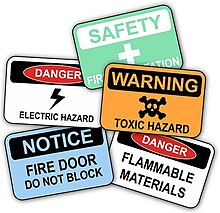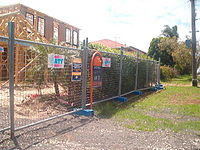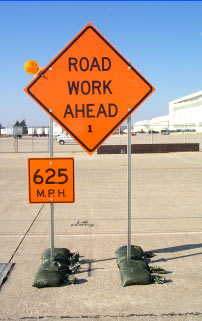Construction site safety: Difference between revisions
No edit summary |
No edit summary |
||
| Line 66: | Line 66: | ||
*Construction Safety Council |
*Construction Safety Council |
||
*ConstructionSafety.org |
*ConstructionSafety.org |
||
*[http://www.cpwr.com CPWR - The Center for Construction Research and Training] |
|||
===Hazards to non-workers=== |
===Hazards to non-workers=== |
||
Many construction sites cannot completely exclude non-workers. Road construction sites must often allow traffic to pass through. This places non-workers at some degree of risk. |
Many construction sites cannot completely exclude non-workers. Road construction sites must often allow traffic to pass through. This places non-workers at some degree of risk. |
||
Revision as of 17:49, 3 October 2012

Construction is the most dangerous land-based work sector in Europe, after the fishing industry. In the European Union, the fatal accident rate is nearly 13 workers per 100,000 as against 5 per 100,000 for the all sector average.</ref>[1]
In the U.S. there were 1,225 fatal occupational injuries in the construction sector in 2001 with an incidence rate of 13.3 per 100,000 employed workers.[2] For the same year the construction industry experienced 481,400 nonfatal injuries and illnesses at a rate of 7.9 per 100 full-time workers in the industry.[3] Construction has about 6% of U.S. workers, but 20% of the fatalities - the largest number of fatalities reported for any industry sector.[4] Hong Kong is also notorious for its high construction accidents rates. Although the accidents rate dropped from 350 per 1000 workers in mid 1980 to 60 per 1000 workers in 2007, it still accounted for nearly 20% of all the industrial accidents in Hong Kong.[5]
The problem is not that the hazards and risks are unknown, it is that they are very difficult to control in a constantly changing work environment.
Construction Fatality Rates
| Country/Region | Fatalities (per Annum per 100,000 Workers) | Year | Notes |
|---|---|---|---|
| EU | 13.3 | 1996 | [6] |
| France | 1 12.1 | 1996 | [7] |
| Germany | 115.4 | 1996 | [8] |
| Ireland | 18.0 | 1996 | [9] |
| Italy | 114.4 | 1996 | [10] |
| United Kingdom | 13.4 | 2009/08 | [11] |
| United States of America | 10.8 | 2006 | [12] |
Nature of hazards
Hazards to construction workers

The leading safety hazards on site are falls from height, motor vehicle crashes, excavation accidents, electrocution, machines, and being struck by falling objects. Some of the main health hazards on site are asbestos, solvents, noise, and manual handling activities.
Falls from heights is the leading cause of injury in the construction industry. In the OSHA Handbook (29 CFR), fall protection is needed in areas and activities that include, but are not limited to: ramps, runways, and other walkways; excavations; hoist areas; holes; formwork; leading edge work; unprotected sides and edges; overhand bricklaying and related work; roofing; precast erection; wall openings; residential construction; and other walking/working surfaces.
The height limit where fall protection is required is not defined. It used to be 2 metres in the previous issue of Work at Height Regulations. It is any height that may result in injury from a fall. Protection is also required when the employee is at risk to falling onto dangerous equipment.
Fall protection can be provided by guardrail systems, safety net systems, personal fall arrest systems, positioning device systems, and warning line systems.
All employees should be trained to understand the proper way to use these systems and to identify hazards. The employee or employer will be responsible for providing fall protection systems and to ensure the use of these systems.
For further information and specifics, 29 CFR list out further instruction in Subpart M.
Motor Vehicle Crashes are another major safety hazard on construction sites. It is important to be safety cautious while operation motor vehicles or Equipment on the site. Motor vehicles shall have a service brake system, emergency brake system, and a parking brake system. All vehicles must be equipped with an audible warning system if the operator chooses to use it. Vehicles must have windows and doors, power windshield wipers, and have a clear view of site from the rear window.
Equipment on the job site must have light and reflectors if intended for night use. The glass in the cab of the equipment must be safety glass. The equipment must be used for their intended task at all times on the job site.
Further instruction can be found in 29 CFR Subpart O.

Before any excavation has taken place, the contractor is responsible for notification of all applicable companies that excavation work is being performed. Location of utilities is a must before breaking ground. During excavation, the contractor is responsible for providing a safe work environment for employees and pedestrians. The contractor shall comply with all standards set forth in 29 CFR Subpart P.
Access and Egress is also an important part of excavation safety. Ramps used by equipment must be designed by a competent person, qualified in structural design.
No person is allowed to cross underneath or stand underneath any loading or digging equipment. Employees are to remain at a safe distance from all equipment while it is operational.
Inspect the equipment before every use.
Further instruction for excavation can be found in 29 CFR Subpart P.
Efforts to Improve Safety
Although construction is one of the worst industries in Europe in terms of safety, there have been, and are, various groups working towards improving construction conditions and safety. Construction conditions have improved ten-fold from 15 years ago, and as technology increases, so does the safety and working conditions of construction jobs. Organizations working toward improving construction safety include:
- Construction Safety Council
- ConstructionSafety.org
- CPWR - The Center for Construction Research and Training
Hazards to non-workers
Many construction sites cannot completely exclude non-workers. Road construction sites must often allow traffic to pass through. This places non-workers at some degree of risk.

Road construction sites are blocked-off and traffic is redirected. The sites and vehicles are protected by signs and barricades. However, sometimes even these signs and barricades can be a hazard to vehicle traffic. For example, improperly designed barricades can cause cars that strike them to roll over or even be thrown into the air. Even a simple safety sign can penetrate the windshield or roof of a car if hit from certain angles. The majority of death in construction are caused by hazards relating to construction activity. However, many deaths are also caused by no construction activities, such as electrical hazards. A notable example of this occurred when Andy Roberts, a father of four, was killed while changing a light bulb at a construction site when he came into contact with a loose bare wire that was carrying two thousand volts of electricity and died. (August 1988 New York (U.S.A)). Events like this motivated the passing of further safety laws relating to non construction activities such as electrical work laws.
Applicable laws
Under European Union Law, there are European Union Directives in place to protect workers, notably Directive 89/391 (the Framework Directive) and Directive 92/57 (the Temporary and Mobile Sites Directive). This legislation is transposed into the Member States and places requirements on employers (and others) to assess and protect workers health and safety.
In the United States the Occupational Safety and Health Administration (OSHA) sets and enforces standards concerning workplace safety and health.
See also
- Occupational Safety
- Construction
- Temporary fencing
- Roof edge protection
- NIOSH Power Tools Database
- Safe-in-Sound Excellence in Hearing Loss Prevention Award
- Safety by design
References
- ^ "Health and safety at work statistics". eurostat. European Commission. Retrieved 3 August 2012.
- ^ BLS. 2002 Census of fatal occupational injuries. Fatal injuries. Washington, DC: U.S. Department of Labor, Bureau of Labor Statistics, Safety and Health Statistics Program [1]
- ^ BLS. Survey of occupational injuries and illnesses. Washington, D.C.: U.S. Department of Labor, Bureau of Labor Statistics, Safety and Health Statistics Program. 2002. Nonfatal (OSHA recordable) injuries and illnesses. Industry incidence rates and counts. [2]
- ^ "NIOSH Construction". United States National Institute for Occupational Safety and Health. Retrieved 2007-10-15.
- ^ "Workers' Compensation for Non-fatal Construction Accidents: Review of Hong Kong Court Cases". Asian Social Science. Retrieved 2011-08-28.
- ^ review: Construction Related Fatality Statistics
- ^ review: Construction Related Fatality Statistics
- ^ review: Construction Related Fatality Statistics
- ^ review: Construction Related Fatality Statistics
- ^ review: Construction Related Fatality Statistics
- ^ "Fatal injury statistics". HSE. Retrieved 2008-12-17.
- ^ Most Dangerous Jobs
External links
- Occupational Safety & Health Administration (OSHA) - US
- WorkCover New South Wales - Australia
- Victoria WorkCover Authority - Australia
- Health and Safety Executive (HSE) - UK
- Department of Labour Health and Safety - New Zealand
- Site Safe Australia
- Construction Safety Association of Ontario (CSAO) - Canada
- Workers Safety and Insurance Board - (WSIB) Canada
- Workers Health and Safety Centre - Canada
- National Institute for Occupational Safety and Health - Construction Safety
- Workplace Fatality’s & the Aftermath United Support & Memorial for Workplace Fatalities
- Construction Fall Hazards SafetyXChange Article
- Construction Safety Network
- CPWR - The Center for Construction Research and Training
- Construction Solutions Construction hazards and ways to eliminate and reduce those hazards.
- Electronic Library of Occupational Safety and Health
- Mi Trabajo Seguro Construction safety information for Spanish-speaking audiences.
- NIOSH Power Tools Sound and Vibrations Database
- New York City construction noise control products and vendor guidance sheet
- European Agency for Health and Safety (EU)
- ER PLUS Risk Management Group Inc.
